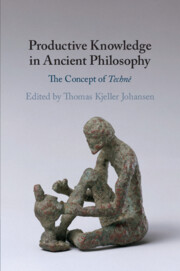Book contents
- Productive Knowledge in Ancient Philosophy
- Productive Knowledge in Ancient Philosophy
- Copyright page
- Contents
- Contributors
- Acknowledgements
- List of Abbreviations
- Introduction
- Chapter 1 Protagoras on Political Technê
- Chapter 2 Dynamic Modalities and Teleological Agency
- Chapter 3 Technê As a Model for Virtue in Plato
- Chapter 4 Crafting the Cosmos
- Chapter 5 Aristotle on Productive Understanding and Completeness
- Chapter 6 Technê and Empeiria
- Chapter 7 The Stoics on Technê and the Technai
- Chapter 8 The Epicureans on Technê and the Technai
- Chapter 9 The Sceptic’s Art
- Chapter 10 Plotinus on the Arts
- Chapter 11 Productive Knowledge in Proclus
- Bibliography
- General Index
- Index Locorum
Chapter 3 - Technê As a Model for Virtue in Plato
Published online by Cambridge University Press: 14 January 2021
- Productive Knowledge in Ancient Philosophy
- Productive Knowledge in Ancient Philosophy
- Copyright page
- Contents
- Contributors
- Acknowledgements
- List of Abbreviations
- Introduction
- Chapter 1 Protagoras on Political Technê
- Chapter 2 Dynamic Modalities and Teleological Agency
- Chapter 3 Technê As a Model for Virtue in Plato
- Chapter 4 Crafting the Cosmos
- Chapter 5 Aristotle on Productive Understanding and Completeness
- Chapter 6 Technê and Empeiria
- Chapter 7 The Stoics on Technê and the Technai
- Chapter 8 The Epicureans on Technê and the Technai
- Chapter 9 The Sceptic’s Art
- Chapter 10 Plotinus on the Arts
- Chapter 11 Productive Knowledge in Proclus
- Bibliography
- General Index
- Index Locorum
Summary
Virtue is agreed to be a technê – or at least very like one – by Socrates, Plato, the Stoics and Aristotle (who is deeply ambivalent about the technê model). But in what ways is technê a useful model for virtue? Barney argues that technê has two important dimensions. First, technê provides a small-scale, well-understood model for the general, unspecialized practical rationality that would constitute virtue. Relevant features of a technê so understood include perceptual, rational and deliberative capacities, and a disinterested orientation to an end. Second, a technê is a practical identity: a social role the adoption of which provides a deliberative standpoint. Adopting a practical identity involves accepting its normative authority: we undertake to be a good doctor, mother, etc. Understanding technê´s normative authority as a practical identity (rather than as knowledge) solves several standard puzzles about virtue as technê. Moreover, the model can be defended against some common objections if virtue is taken as a kind of ‘super-technê’, with the human good as its end and, accordingly, some special features: it directs all the other technai, its adoption as a practical identity is non-optional for a rational human being, and its reasons for action are non-defeasible.
- Type
- Chapter
- Information
- Productive Knowledge in Ancient PhilosophyThe Concept of <I>Technê</I>, pp. 62 - 85Publisher: Cambridge University PressPrint publication year: 2021
- 3
- Cited by

